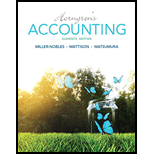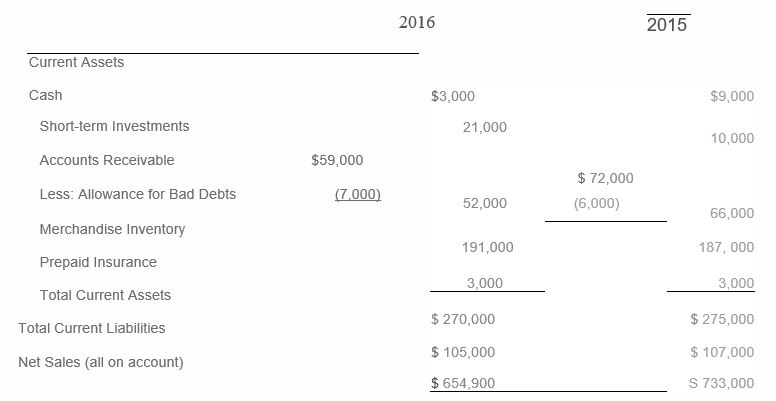
Horngren's Accounting (11th Edition)
11th Edition
ISBN: 9780133856781
Author: Tracie L. Miller-Nobles, Brenda L. Mattison, Ella Mae Matsumura
Publisher: PEARSON
expand_more
expand_more
format_list_bulleted
Textbook Question
Chapter 9, Problem E9.25E
Evaluating ratio data
Chippewa Carpets reported the following amounts in its 2016 financial statement. The 2015 figures are given for comparison.

Requirements
- Calculate Chippewa’s acid-test ratio for 2016. (Round to two decimals.) Determine whether Chippewa's acid-test ratio improved or deteriorated from 2015 to 2016. How does Chippewa’s acid-test ratio compare with the industry average of 0.80?
- Calculate Chippewa’s
accounts receivable turnover ratio. (Round to two decimals.) How does Chippewa’s ratio compare to the industry average amounts receivable turnover of 10? *
- Calculate the days’ sales in receivables for 2016. (Round to the nearest day.) How do the results compare with Chippewa’s credit terms of net 30?
Expert Solution & Answer
Want to see the full answer?
Check out a sample textbook solution
Students have asked these similar questions
answer plz
The financial statement which reports investments from owners and distributions to owners during a particular period is:
Sub: general Accounting
Chapter 9 Solutions
Horngren's Accounting (11th Edition)
Ch. 9 - 1. With good internal controls, the person who...Ch. 9 - Prob. 2QCCh. 9 - Which of the following is a limitation of the...Ch. 9 - 3. The entry to record a write-off of an...Ch. 9 - Brickman Company uses the allowance method to...Ch. 9 - Brickman’s ending balance of accounts Receivable...Ch. 9 - At December 31 year-end, Crain Company has an...Ch. 9 - Using the data in the preceding question, what...Ch. 9 - At year-end, Schultz Company has cash of $11,600,...Ch. 9 - Using the data in the preceding question, assume...
Ch. 9 - What is the difference between accounts receivable...Ch. 9 - List some common examples of other receivables,...Ch. 9 - Prob. 3RQCh. 9 - When dealing with receivables, give an example of...Ch. 9 - What type of account must the sum of all...Ch. 9 - Prob. 6RQCh. 9 - What occurs when a business factors its...Ch. 9 - What occurs when a business pledges its...Ch. 9 - What is the expense account associated with the...Ch. 9 - When is bad debts expense recorded when using the...Ch. 9 - What are some limitations of using the direct...Ch. 9 - Prob. 12RQCh. 9 - Prob. 13RQCh. 9 - When using the allowance method, what account is...Ch. 9 - Prob. 15RQCh. 9 - Prob. 16RQCh. 9 - How do the percent-of-receivables and...Ch. 9 - What is the difference between the...Ch. 9 - In accounting for bad debts, how do the income...Ch. 9 - What is the formula to compute interest on a note...Ch. 9 - Prob. 21RQCh. 9 - Prob. 22RQCh. 9 - Prob. 23RQCh. 9 - Prob. 24RQCh. 9 - Prob. S9.1SECh. 9 - Prob. S9.2SECh. 9 - Applying the direct write-off method to account...Ch. 9 - Collecting a receivable previously written...Ch. 9 - Applying die allowance method to account for...Ch. 9 - Applying the allowance method (percent-of-sales)...Ch. 9 - Applying the allowance method...Ch. 9 - Applying the allowance method...Ch. 9 - Computing interest amounts on notes receivable A...Ch. 9 - Accounting for a note receivable On June 6,...Ch. 9 - Accruing interest revenue and recording collection...Ch. 9 - Recording a dishonored note receivable Midway...Ch. 9 - Using the acid-test ratio, accounts receivable...Ch. 9 - Defining common receivables terms Learning...Ch. 9 - E9-15 Identifying and correcting internal control...Ch. 9 - Journalizing transactions using the direct...Ch. 9 - Prob. E9.17ECh. 9 - Prob. E9.18ECh. 9 - Accounting for uncollectible accounts using the...Ch. 9 - Prob. E9.20ECh. 9 - Prob. E9.21ECh. 9 - Journalizing note receivable transactions...Ch. 9 - Journalizing note receivable transactions The...Ch. 9 - Journalizing note receivable transactions Like New...Ch. 9 - Evaluating ratio data Chippewa Carpets reported...Ch. 9 - Prob. E9.26ECh. 9 - Accounting for uncollectible accounts using the...Ch. 9 - Accounting for uncollectible accounts using the...Ch. 9 - Accounting for uncollectible accounts using the...Ch. 9 - Prob. P9.30APGACh. 9 - Accounting for notes receivable and accruing...Ch. 9 - Accounting for notes receivable, dishonored notes,...Ch. 9 - Prob. P9.33APGACh. 9 - Prob. P9.34BPGBCh. 9 - Prob. P9.35BPGBCh. 9 - Prob. P9.36BPGBCh. 9 - Prob. P9.37BPGBCh. 9 - Prob. P9.38BPGBCh. 9 - Prob. P9.39BPGBCh. 9 - Prob. P9.40BPGBCh. 9 - Prob. P9.41CPCh. 9 - Accounting for uncollectible accounts using the...Ch. 9 - Decision Case 9-1 Weddings on Demand sells on...Ch. 9 - Decision Case 9-2 Pauline’s Pottery has always...Ch. 9 - Prob. 9.1FCCh. 9 - > Financial Statement Case 9-1 Use Starbucks...
Knowledge Booster
Learn more about
Need a deep-dive on the concept behind this application? Look no further. Learn more about this topic, accounting and related others by exploring similar questions and additional content below.Similar questions
- The Esquire Clothing Company borrowed a sum of cash on October 1, 2024, and signed a note payable. The annual interest rate was 12%. The company's December 31, 2024, income statement reported interest expense of $1,260 related to this note. What was the amount borrowed?arrow_forwardThe Wazoo Company reported an $11,200 liability in its 2023 balance sheet for subscription revenue received in advance. During 2024, $62,000 was received from customers for subscriptions and the 2024 income statement reported subscription revenue of $63,700. What is the liability amount for deferred subscription revenue that will appear in the 2024 balance sheet?arrow_forwardWe can state the accounting equation for a corporation as:arrow_forward
arrow_back_ios
SEE MORE QUESTIONS
arrow_forward_ios
Recommended textbooks for you
 Financial AccountingAccountingISBN:9781305088436Author:Carl Warren, Jim Reeve, Jonathan DuchacPublisher:Cengage LearningPrinciples of Accounting Volume 1AccountingISBN:9781947172685Author:OpenStaxPublisher:OpenStax College
Financial AccountingAccountingISBN:9781305088436Author:Carl Warren, Jim Reeve, Jonathan DuchacPublisher:Cengage LearningPrinciples of Accounting Volume 1AccountingISBN:9781947172685Author:OpenStaxPublisher:OpenStax College Financial Accounting: The Impact on Decision Make...AccountingISBN:9781305654174Author:Gary A. Porter, Curtis L. NortonPublisher:Cengage Learning
Financial Accounting: The Impact on Decision Make...AccountingISBN:9781305654174Author:Gary A. Porter, Curtis L. NortonPublisher:Cengage Learning Cornerstones of Financial AccountingAccountingISBN:9781337690881Author:Jay Rich, Jeff JonesPublisher:Cengage Learning
Cornerstones of Financial AccountingAccountingISBN:9781337690881Author:Jay Rich, Jeff JonesPublisher:Cengage Learning

Financial Accounting
Accounting
ISBN:9781305088436
Author:Carl Warren, Jim Reeve, Jonathan Duchac
Publisher:Cengage Learning

Principles of Accounting Volume 1
Accounting
ISBN:9781947172685
Author:OpenStax
Publisher:OpenStax College


Financial Accounting: The Impact on Decision Make...
Accounting
ISBN:9781305654174
Author:Gary A. Porter, Curtis L. Norton
Publisher:Cengage Learning

Cornerstones of Financial Accounting
Accounting
ISBN:9781337690881
Author:Jay Rich, Jeff Jones
Publisher:Cengage Learning

How To Analyze an Income Statement; Author: Daniel Pronk;https://www.youtube.com/watch?v=uVHGgSXtQmE;License: Standard Youtube License